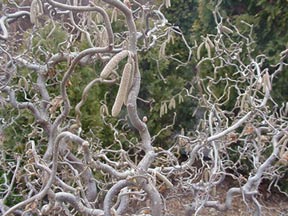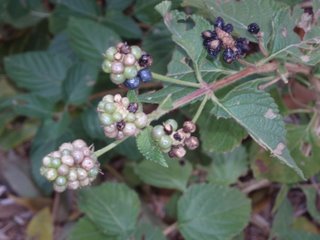More Fall Color
One of the hardest things to remember as a designer, at least for me, is multiple season interest. There are times I get hung up on my plant-du-jure and that is all I can think about putting in all my designs. Luckily in Oklahoma there are plenty of plants that do well and have multiple season interest and I have managed to fall in love with almost all of them.
Ok, so what am I talking about when I say multi season interest? Well, it can be a lot of things. A lot of times we notice the flowers and don't really pay attention to anything else about the plant. Other times we think about the fall color. But there are a lot of things you can plant that don't really have fancy flowers or stupendous fall color that can still give you some interest in the landscape. For instance, structural interest. Harry Lauder's walking stick, or contorted filbert, does well in Oklahoma.  During the Spring and Summer it mostly has a rich green color that makes a nice backdrop to other plants, in the fall the leaves turn a blah yellow and fall off soon, but in the winter time, especially after an ice or snow storm it has a structural interest that will beat just about everything else around.
During the Spring and Summer it mostly has a rich green color that makes a nice backdrop to other plants, in the fall the leaves turn a blah yellow and fall off soon, but in the winter time, especially after an ice or snow storm it has a structural interest that will beat just about everything else around.
In case you weren't impressed with the pics of the bald cypress the other day, here is one that is a little more into the color change. A nice reddish rust color and good even branching. An altogether wonderful tree. Great in wet spots, handles drought, can stand up to the hottest weather Oklahoma can come up with. The only thing it is picky about is that it has to have full sun. I have seen some planted in a grove style that are completely one-sided because another was shading it out.
A nice reddish rust color and good even branching. An altogether wonderful tree. Great in wet spots, handles drought, can stand up to the hottest weather Oklahoma can come up with. The only thing it is picky about is that it has to have full sun. I have seen some planted in a grove style that are completely one-sided because another was shading it out.
Well, I know y'all are probably bored with it, but I don't care. I am still in love with the Chinese pistache. Great tree, grows wonderfully and has color like this. Which brings me to my other thing about multi-season interest. A lot of plants have flowers that are not really noticeable or don't last very long but then they have fruit that persists until the birds finally strip it. Chinese pistache is one of these. This is the fruit on the female pistache.
Which brings me to my other thing about multi-season interest. A lot of plants have flowers that are not really noticeable or don't last very long but then they have fruit that persists until the birds finally strip it. Chinese pistache is one of these. This is the fruit on the female pistache. Some of the trees will be completely covered in these fruiting structures and you won't even notice until a wind storm comes by (like the one the weather men are panicking about for tonight) that strips the leaves and all of a sudden you'll notice these beautiful reddish, pinkish berries all over the tree. Unless the wind is particularly hard and then you'll notice them all over your yard. Well, landscaping, like life, has it's trade-offs.
Some of the trees will be completely covered in these fruiting structures and you won't even notice until a wind storm comes by (like the one the weather men are panicking about for tonight) that strips the leaves and all of a sudden you'll notice these beautiful reddish, pinkish berries all over the tree. Unless the wind is particularly hard and then you'll notice them all over your yard. Well, landscaping, like life, has it's trade-offs.
Ok, speaking of fruiting structures. Lantana is one of my favorite perennials. And one of the reasons is its fruit. The berries start out green and then turn anywhere from pink, red, blue, purple or black. And all on the same plant! Wondrous! As far as cool fruiting structure go, there is really none so cool as moonflower vine (the one related to morning glories, not the datura). It is an annual, so it's kind of a hassle to keep planting it, but this year we were trying to have something on the arch while trying to get rid of the passion flower. Yes, I love passion flower, but there is also a butterfly larva that loves it and they stripped the vines last year so that it looked really ugly and didn't flower at all. And while I love having the butterflies and to do that you need something for the larva to feed on, what they are feeding on doesn't need to be right on the front walk so that everybody in the world sees it first thing! Anyway, here is the fruit for moonflower.
As far as cool fruiting structure go, there is really none so cool as moonflower vine (the one related to morning glories, not the datura). It is an annual, so it's kind of a hassle to keep planting it, but this year we were trying to have something on the arch while trying to get rid of the passion flower. Yes, I love passion flower, but there is also a butterfly larva that loves it and they stripped the vines last year so that it looked really ugly and didn't flower at all. And while I love having the butterflies and to do that you need something for the larva to feed on, what they are feeding on doesn't need to be right on the front walk so that everybody in the world sees it first thing! Anyway, here is the fruit for moonflower. Is that the coolest thing or what?
Is that the coolest thing or what?
Now you don't have to know what the plant is to notice how pretty something is about it. This is off a vine that my neighbor has. I don't know what it is, don't particularly like it because it is filled with thorns, don't notice when it flowers because they are small and blah, but during the fall it has these all over! And the birds love them as much as I do. Maybe more.
And the birds love them as much as I do. Maybe more.
Ok, last but not least. Until a few years ago, the state flower of Oklahoma was the mistletoe (then since the State legislature didn't have anything more pressing to do, since life here is so idyllic) they changed it to the Indian blanket. Anyway, the mistletoe is supposed to be a parasite that will kill a tree (not true, it roots into the bark crevices and is fed by bird poop) and I will admit that it isn't all that attractive. Though you have to give it props for that whole kissing thing, and according to legend (don't know if it is true or not) the reason it was made the state flower in the first place is because some settlers wife died and he put flowers on her grave for her birthday every year in January and the only plant he could find green around his cabin that time of year was mistletoe so he petitioned his representative to honor it (all together now, AAAAAAWWWWWWW). Anyway, you have to admit that it looks kinda cool when the trees are bare and it has the berries all over it. When it's low enough to see the berries.
Sorry it's a little blurry, there is only so much that photo-pro can do after you crop so you can see what you're supposed to be looking at.
So, that pretty much is all I have to say for now. Laura and the kids will be here in about a week. So then I'll have Ryan and Erin to play with and irritate with my camera. Until then, Take care of yourselves and be nice to someone that you usually don't notice today. It just might keep them from going over the edge.
Wayne


2 Comments:
Great information, Wayne. The walking stick plant is amazing.
I have a question. On the Chinese pistache tree...can you tell when you are shopping for a small one if it is a male or female?
One of my passions is birding/bird feeding/natural plantings for birds. We planted several mulberry trees, but it was a wait and see as to which ones would bear fruit. I'd like to plant more females than males to help out the birds. We have native dogwoods that produce berry fruits, but the birds strip them before the weather gets truly cold. And, the wild sumac is a great food source for Bluebirds in winter...which is why it is difficult for me to decide to cut any down.
May need to get a Chinese pistache! : )
Look on the id tag in the store, it should identify the tree as male or female. Another great small tree/large shrub for the birds is Washington or cockspur hawthorns. Be sure to plant away from people because they are thorny. And we have elderberry bushes that we have had for about three years that I have gotten two berries off of. Between the birds and the squirrels they are stripped by mid-summer.
Post a Comment
<< Home